Long-Term Trends in 20-Day Cumulative Precipitation for Residential Rainwater Harvesting in Poland
Abstract
1. Introduction
2. Materials and Methods
2.1. Rainfall Data
2.2. Rainwater Storage Period and Tank Capacity
2.3. Research Methods
3. Results
3.1. Precipitation Potential
3.2. Trends of Change
4. Discussion
5. Conclusions
Author Contributions
Funding
Conflicts of Interest
References
- Gutry-Korycka, M.; Sadurski, A.; Kundzewicz, Z.; Pociask-Karteczka, J.; Skrzypczyk, L.; Pociask-Karteczka, J. Zasoby wodne a ich wykorzystanie. Nauka 2014, 1, 77–98. [Google Scholar]
- Olichwer, T. Long-term variability of water resources in mountainous areas: Case Study—Kłodzko region (SW Poland). Carpathian J. Earth Environ. Sci. 2019, 14, 29–38. [Google Scholar] [CrossRef]
- Małecki, Z.J.; Gołębiak, P. Zasoby wodne Polski i świata. Zesz. Nauk. Inżynieria Lądowa Wodna Kształtowaniu Środowiska 2012, 7, 50–56. [Google Scholar]
- Kuczyński, W.; Zuchowicki, W. Ocena aktualnej sytuacji w zaopatrzeniu w wode{ogonek} w Polsce na tle sytuacji w świecie. Rocz. Ochr. Sr. 2011, 12, 419–465. [Google Scholar]
- Orlińska-Woźniak, P.; Wilk, P.; Gębala, J. Water availability in reference to water needs in Poland. Meteorol. Hydrol. Water Manag. 2014, 1, 45–50. [Google Scholar] [CrossRef][Green Version]
- Suchożebrski, J. Zasoby wodne Polski. In Zarządzanie Zasobami Wodnymi w Polsce; Global Compact Network Poland: Warsaw, Poland, 2018; pp. 92–96. [Google Scholar]
- Panasiuk, D.; Suduk, O.; Skrypchuk, P.; Miłaszewski, R. Comparison of the water footprint in Poland and Ukraine. Ekon. Środowisko 2018, 4, 112–123. [Google Scholar]
- Michalczyk, Z. Odpływ średni, zmienność w czasie i zróżnicowanie przestrzenne. In Hydrologia Polski; Jokiel, P., Marszelewski, W., Pociask-Karteczka, J., Eds.; Wydawnictwo Naukowe PWN SA: Warsaw, Poland, 2017; ISBN 978-83-01-19618-9. [Google Scholar]
- Hegerl, G.C.; Black, E.; Allan, R.P.; Ingram, W.J.; Polson, D.; Trenberth, K.E.; Chadwick, R.S.; Arkin, P.A.; Sarojini, B.B.; Becker, A.; et al. Challenges in Quantifying Changes in the Global Water Cycle. Bull. Am. Meteorol. Soc. 2015, 96, 1097–1115. [Google Scholar] [CrossRef]
- Falloon, P.; Betts, R. Climate impacts on European agriculture and water management in the context of adaptation and mitigation—The importance of an integrated approach. Sci. Total Environ. 2010, 408, 5667–5687. [Google Scholar] [CrossRef]
- Kundzewicz, Z.W.; Matczak, P. Climate change regional review: Poland. Wiley Interdiscip. Rev. Clim. Chang. 2012, 3, 297–311. [Google Scholar] [CrossRef]
- Lipińska, D. European Union Water Policy: Key Issues and Challenges. Comp. Econ. Res. Cent. East Eur. 2012, 15, 123–141. [Google Scholar] [CrossRef][Green Version]
- Kutyłowska, M. Forecasting failure rate of water pipes. Water Supply 2019, 19, 264–273. [Google Scholar] [CrossRef]
- Piasecki, A.; Jurasz, J.; Kaźmierczak, B. Forecasting Daily Water Consumption: A Case Study in Torun, Poland. Period. Polytech. Civ. Eng. 2018, 62, 818–824. [Google Scholar] [CrossRef]
- Dawidowicz, J.; Czapczuk, A.; Piekarski, J. The Application of Artificial Neural Networks in the Assessment of Pressure Losses in Water Pipes in the Design of Water Distribution Systems. Rocz. Ochr. Środowiska 2018, 20, 292–308. [Google Scholar]
- Ward, S.; Barr, S.; Memon, F.; Butler, D. Rainwater harvesting in the UK: Exploring water-user perceptions. Urban. Water J. 2013, 10, 112–126. [Google Scholar] [CrossRef]
- Steffen, J.; Jensen, M.; Pomeroy, C.A.; Burian, S.J. Water Supply and Stormwater Management Benefits of Residential Rainwater Harvesting in U.S. Cities. JAWRA J. Am. Water Resour. Assoc. 2013, 49, 810–824. [Google Scholar] [CrossRef]
- Torres, M.N.; Fontecha, J.E.; Zhu, Z.; Walteros, J.L.; Rodríguez, J.P. A participatory approach based on stochastic optimization for the spatial allocation of Sustainable Urban Drainage Systems for rainwater harvesting. Environ. Model. Softw. 2020, 123, 104532. [Google Scholar] [CrossRef]
- Deitch, M.J.; Feirer, S.T. Cumulative impacts of residential rainwater harvesting on stormwater discharge through a peri-urban drainage network. J. Environ. Manag. 2019, 243, 127–136. [Google Scholar] [CrossRef]
- Teston, A.; Teixeira, C.; Ghisi, E.; Cardoso, E. Impact of Rainwater Harvesting on the Drainage System: Case Study of a Condominium of Houses in Curitiba, Southern Brazil. Water 2018, 10, 1100. [Google Scholar] [CrossRef]
- Semaan, M.; Day, S.D.; Garvin, M.; Ramakrishnan, N.; Pearce, A. Optimal sizing of rainwater harvesting systems for domestic water usages: A systematic literature review. Resour. Conserv. Recycl. X 2020, 6, 100033. [Google Scholar] [CrossRef]
- Council of the European Union. Council Directive 98/83/EC of 3 November 1998 on the Quality of Water Intended for Human Consumption; Council of the European Union: Brussel, Belgium, 1998. [Google Scholar]
- European Parliament; Council of the European Union. Directive 2006/7/EC of the European Parliament and of the Council of 15 February 2006 Concerning the Management of Bathing Water Quality and Eepealing Directive 76/160/EEC; Council of the European Union: Brussel, Belgium, 2006. [Google Scholar]
- Jeong, G.Y.; Kim, J.Y.; Seo, J.; Kim, G.M.; Jin, H.C.; Chun, Y. Long-range transport of giant particles in Asian dust identified by physical, mineralogical, and meteorological analysis. Atmos. Chem. Phys. 2014, 14, 505–521. [Google Scholar] [CrossRef]
- Richon, C.; Dutay, J.-C.; Dulac, F.; Wang, R.; Balkanski, Y. Modeling the biogeochemical impact of atmospheric phosphate deposition from desert dust and combustion sources to the Mediterranean Sea. Biogeosciences 2018, 15, 2499–2524. [Google Scholar] [CrossRef]
- Orlović-Leko, P.; Vidović, K.; Ciglenečki, I.; Omanović, D.; Sikirić, M.D.; Šimunić, I. Physico-Chemical Characterization of an Urban Rainwater (Zagreb, Croatia). Atmos. Basel 2020, 11, 144. [Google Scholar] [CrossRef]
- Kieber, R.J.; Peake, B.; Willey, J.D.; Avery, G.B. Dissolved organic carbon and organic acids in coastal New Zealand rainwater. Atmos. Environ. 2002, 36, 3557–3563. [Google Scholar] [CrossRef]
- Zdeb, M.; Zamorska, J.; Papciak, D.; Słyś, D. The Quality of Rainwater Collected from Roofs and the Possibility of Its Economic Use. Resources 2020, 9, 12. [Google Scholar] [CrossRef]
- Kus, B.; Kandasamy, J.; Vigneswaran, S.; Shon, H.K. Analysis of first flush to improve the water quality in rainwater tanks. Water Sci. Technol. 2010, 61, 421–428. [Google Scholar] [CrossRef]
- Song, Y.; Du, X.; Ye, X. Analysis of Potential Risks Associated with Urban Stormwater Quality for Managed Aquifer Recharge. Int. J. Environ. Res. Public Health 2019, 16, 3121. [Google Scholar] [CrossRef]
- Willey, J.D.; Kieber, R.J.; Eyman, M.S.; Avery, G.B. Rainwater dissolved organic carbon: Concentrations and global flux. Glob. Biogeochem. Cycles 2000, 14, 139–148. [Google Scholar] [CrossRef]
- Helmreich, B.; Horn, H. Opportunities in rainwater harvesting. Desalination 2009, 248, 118–124. [Google Scholar] [CrossRef]
- Kaushik, R.; Balasubramanian, R. Assessment of bacterial pathogens in fresh rainwater and airborne particulate matter using Real-Time PCR. Atmos. Environ. 2012, 46, 131–139. [Google Scholar] [CrossRef]
- Leong, J.Y.C.; Oh, K.S.; Poh, P.E.; Chong, M.N. Prospects of hybrid rainwater-greywater decentralised system for water recycling and reuse: A review. J. Clean. Prod. 2017, 142, 3014–3027. [Google Scholar] [CrossRef]
- Al-Khatib, I.; Arafeh, G.; Al-Qutob, M.; Jodeh, S.; Hasan, A.; Jodeh, D.; van der Valk, M. Health Risk Associated with Some Trace and Some Heavy Metals Content of Harvested Rainwater in Yatta Area, Palestine. Water 2019, 11, 238. [Google Scholar] [CrossRef]
- Huston, R.; Chan, Y.C.; Chapman, H.; Gardner, T.; Shaw, G. Source apportionment of heavy metals and ionic contaminants in rainwater tanks in a subtropical urban area in Australia. Water Res. 2012, 46, 1121–1132. [Google Scholar] [CrossRef] [PubMed]
- Mendez, C.B.; Klenzendorf, J.B.; Afshar, B.R.; Simmons, M.T.; Barrett, M.E.; Kinney, K.A.; Kirisits, M.J. The effect of roofing material on the quality of harvested rainwater. Water Res. 2011, 45, 2049–2059. [Google Scholar] [CrossRef] [PubMed]
- Gikas, G.D.; Tsihrintzis, V.A. Effect of first-flush device, roofing material, and antecedent dry days on water quality of harvested rainwater. Environ. Sci. Pollut. Res. 2017, 24, 21997–22006. [Google Scholar] [CrossRef] [PubMed]
- Sneyers, R. On the Statistical Analysis of Series of Observations. WMO Technical Note No.143; World Meteorological Organization: Geneva, Switzerland, 1990. [Google Scholar]
- Coombes, P.J.; Barry, M.E. The effect of selection of time steps and average assumptions on the continuous simulation of rainwater harvesting strategies. Water Sci. Technol. 2007, 55, 125–133. [Google Scholar] [CrossRef] [PubMed]
- IMGW Polish Institute of Meteorology and Water Management—National Research Institute (IMGW). Available online: https://www.imgw.pl/instytut/imgw-pib (accessed on 2 January 2020).
- Pińskwar, I.; Choryński, A.; Graczyk, D.; Kundzewicz, Z.W. Observed changes in extreme precipitation in Poland: 1991–2015 versus 1961–1990. Theor. Appl. Climatol. 2018, 135, 773–787. [Google Scholar] [CrossRef]
- Lupikasza, E. Spatial and temporal variability of extreme precipitation in Poland in the period 1951–2006. Int. J. Climatol. 2010, 30, 991–1007. [Google Scholar] [CrossRef]
- Kaźmierczak, B.; Wdowikowski, M.; Gwoździej-Mazur, J. Trends in daily changes of precipitation on the example of Wrocław. Ekon. Sr. 2019, 1, 142–151. [Google Scholar]
- Urban, G.; Richterová, D.; Kliegrová, S.; Zusková, I. Durability of snow cover and its long-term variability in the Western Sudetes Mountains. Theor. Appl. Climatol. 2019, 137, 2681–2695. [Google Scholar] [CrossRef]
- Struk-Sokołowska, J.; Gwoździej-Mazur, J.; Jadwiszczak, P.; Butarewicz, A.; Ofman, P.; Wdowikowski, M.; Kaźmierczak, B. The Quality of Stored Rainwater for Washing Purposes. Water 2020, 12, 252. [Google Scholar] [CrossRef]
- Ndehedehe, C.E.; Ferreira, V.G. Assessing land water storage dynamics over South America. J. Hydrol. 2020, 580, 124339. [Google Scholar] [CrossRef]
- Sharma, S.; Mujumdar, P.P. On the relationship of daily rainfall extremes and local mean temperature. J. Hydrol. 2019, 572, 179–191. [Google Scholar] [CrossRef]
- Ali, R.; Ismael, A.; Heryansyah, A.; Nawaz, N. Long Term Historic Changes in the Flow of Lesser Zab River, Iraq. Hydrology 2019, 6, 22. [Google Scholar] [CrossRef]
- Langat, P.; Kumar, L.; Koech, R. Temporal Variability and Trends of Rainfall and Streamflow in Tana River Basin, Kenya. Sustainability 2017, 9, 1963. [Google Scholar] [CrossRef]
- Arrieta-Castro, M.; Donado-Rodríguez, A.; Acuña, G.J.; Canales, F.A.; Teegavarapu, R.S.V.; Kaźmierczak, B. Analysis of Streamflow Variability and Trends in the Meta River, Colombia. Water 2020, 12, 1451. [Google Scholar] [CrossRef]
- Jaiswal, R.K.; Lohani, A.K.; Tiwari, H.L. Statistical Analysis for Change Detection and Trend Assessment in Climatological Parameters. Environ. Process. 2015, 2, 729–749. [Google Scholar] [CrossRef]
- Wijngaard, J.B.; Klein Tank, A.M.G.; Können, G.P. Homogeneity of 20th century European daily temperature and precipitation series. Int. J. Climatol. 2003, 23, 679–692. [Google Scholar] [CrossRef]
- Ledvinka, O.; Lamacova, A. Detection of field significant long-term monotonic trends in spring yields. Stoch. Environ. Res. Risk Assess. 2015, 29, 1463–1484. [Google Scholar] [CrossRef]
- Yue, S.; Pilon, P.; Phinney, B.; Cavadias, G. The influence of autocorrelation on the ability to detect trend in hydrological series. Hydrol. Process. 2002, 16, 1807–1829. [Google Scholar] [CrossRef]
- Onyutha, C. Statistical Uncertainty in Hydrometeorological Trend Analyses. Adv. Meteorol. 2016, 2016, 8701617. [Google Scholar] [CrossRef]
- Wagesho, N.; Goel, N.K.; Jain, M.K. Investigation of non-stationarity in hydro-climatic variables at Rift Valley lakes basin of Ethiopia. J. Hydrol. 2012, 444–445, 113–133. [Google Scholar] [CrossRef]
- Makki, A.A.; Stewart, R.A.; Panuwatwanich, K.; Beal, C. Revealing the determinants of shower water end use consumption: Enabling better targeted urban water conservation strategies. J. Clean. Prod. 2013, 60, 129–146. [Google Scholar] [CrossRef]
- Lee, M.; Tansel, B.; Balbin, M. Influence of residential water use efficiency measures on household water demand: A four year longitudinal study. Resour. Conserv. Recycl. 2011, 56, 1–6. [Google Scholar] [CrossRef]
- Lee, M.; Tansel, B. Water conservation quantities vs customer opinion and satisfaction with water efficient appliances in Miami, Florida. J. Environ. Manag. 2013, 128, 683–689. [Google Scholar] [CrossRef] [PubMed]
- Polish Geological Institute Groundwater Resources in Poland. Available online: https://www.pgi.gov.pl/en/phs/tasks/8862-groundwater-resources-in-poland.html (accessed on 6 June 2020).
- Witkowski, A.J.; Kowalczyk, A.; Rubin, H.; Rubin, K. Groundwater quality and migration of pollutants in the multi-aquifer system of the former chemical works “Tarnowskie Góry” area. Polish Geol. Inst. Spec. Pap. 2008, 24, 123–130. [Google Scholar]
- Montcoudiol, N.; Isherwood, C.; Gunning, A.; Kelly, T.; Younger, P.L. Shale gas impacts on groundwater resources: Understanding the behavior of a shallow aquifer around a fracking site in Poland. Energy Procedia 2017, 125, 106–115. [Google Scholar] [CrossRef]
- Jakóbczyk-Karpierz, S.; Ślósarczyk, K.; Sitek, S. Tracing multiple sources of groundwater pollution in a complex carbonate aquifer (Tarnowskie Góry, southern Poland) using hydrogeochemical tracers, TCE, PCE, SF6 and CFCs. Appl. Geochem. 2020, 118. [Google Scholar] [CrossRef]

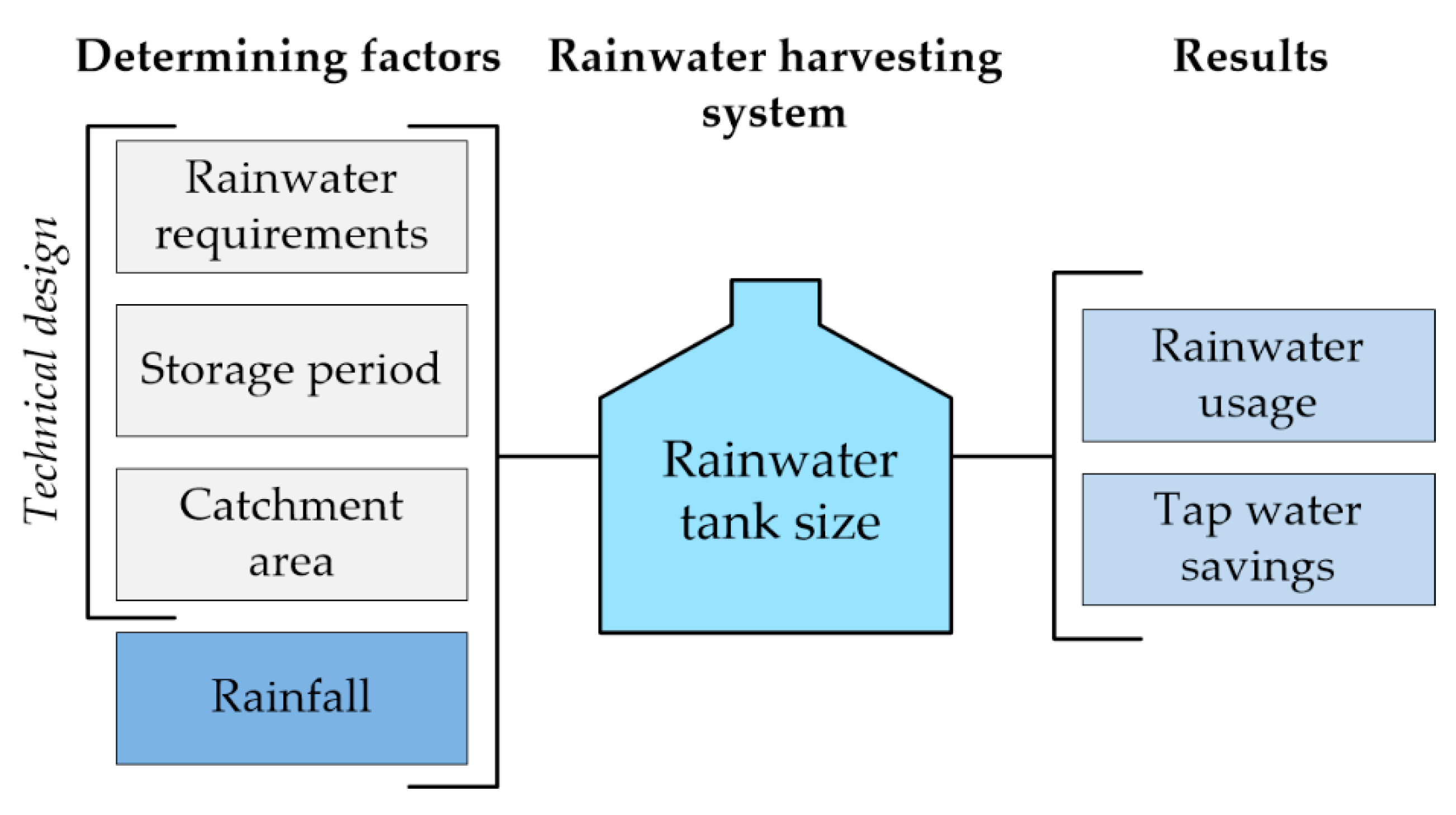

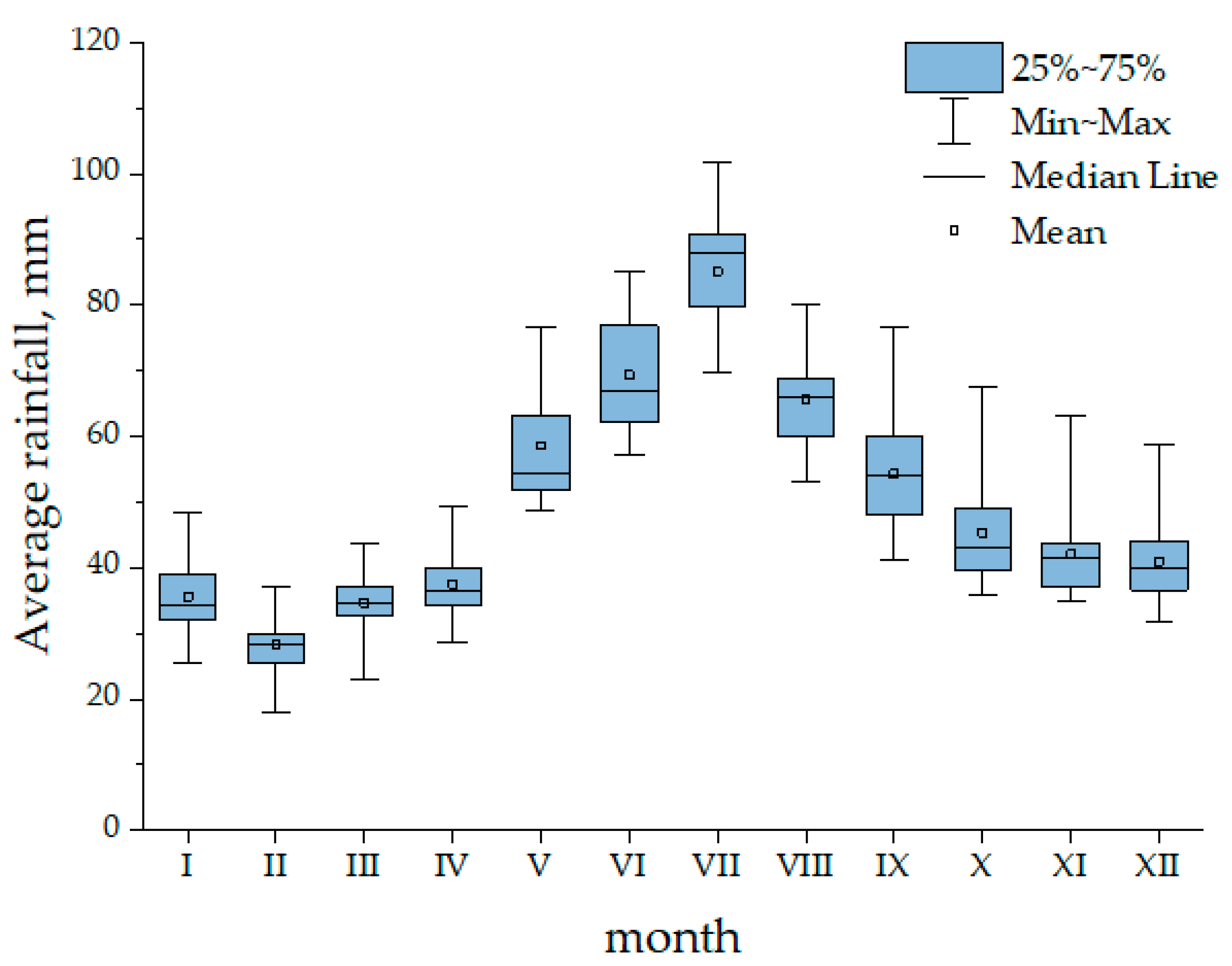

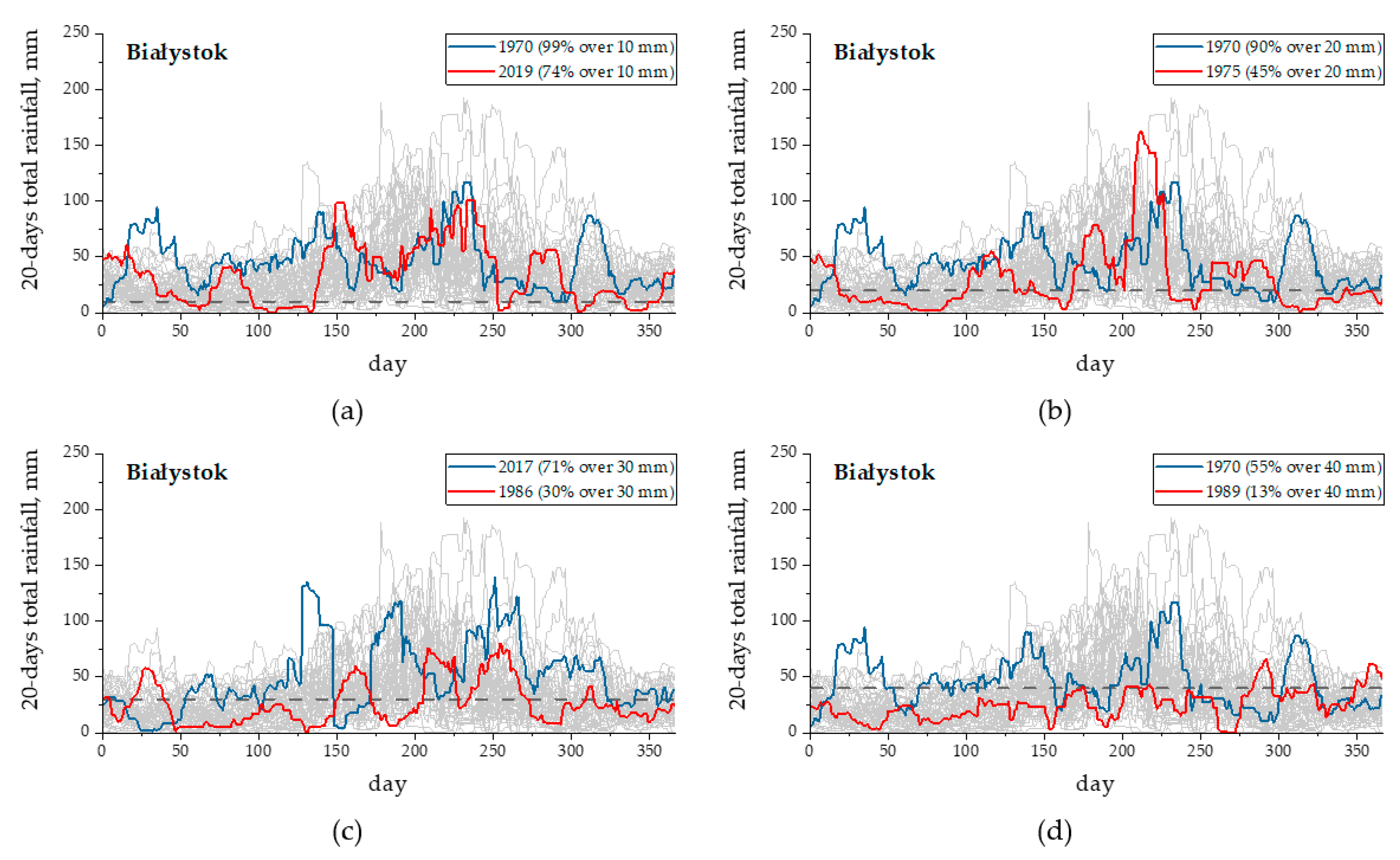
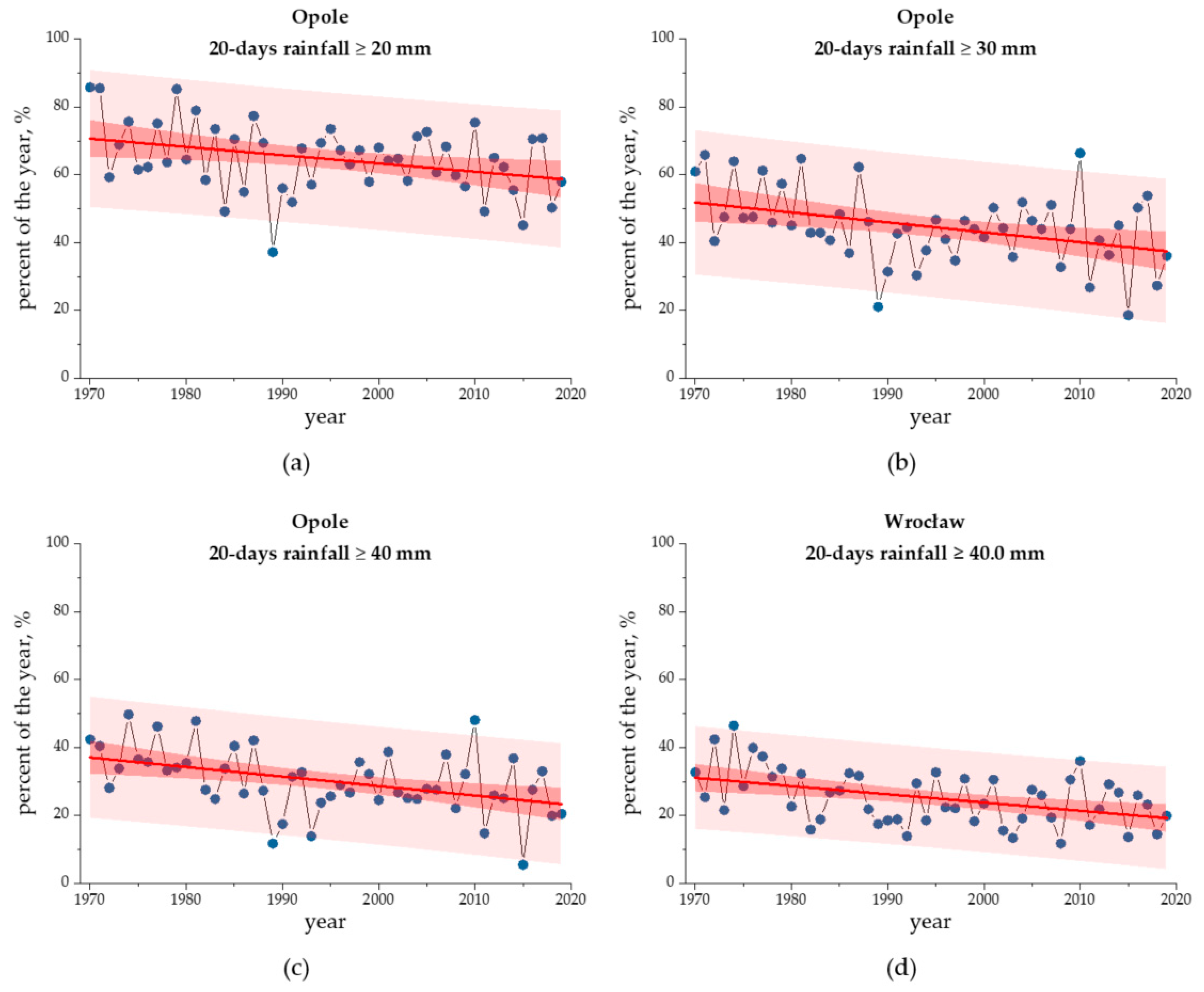
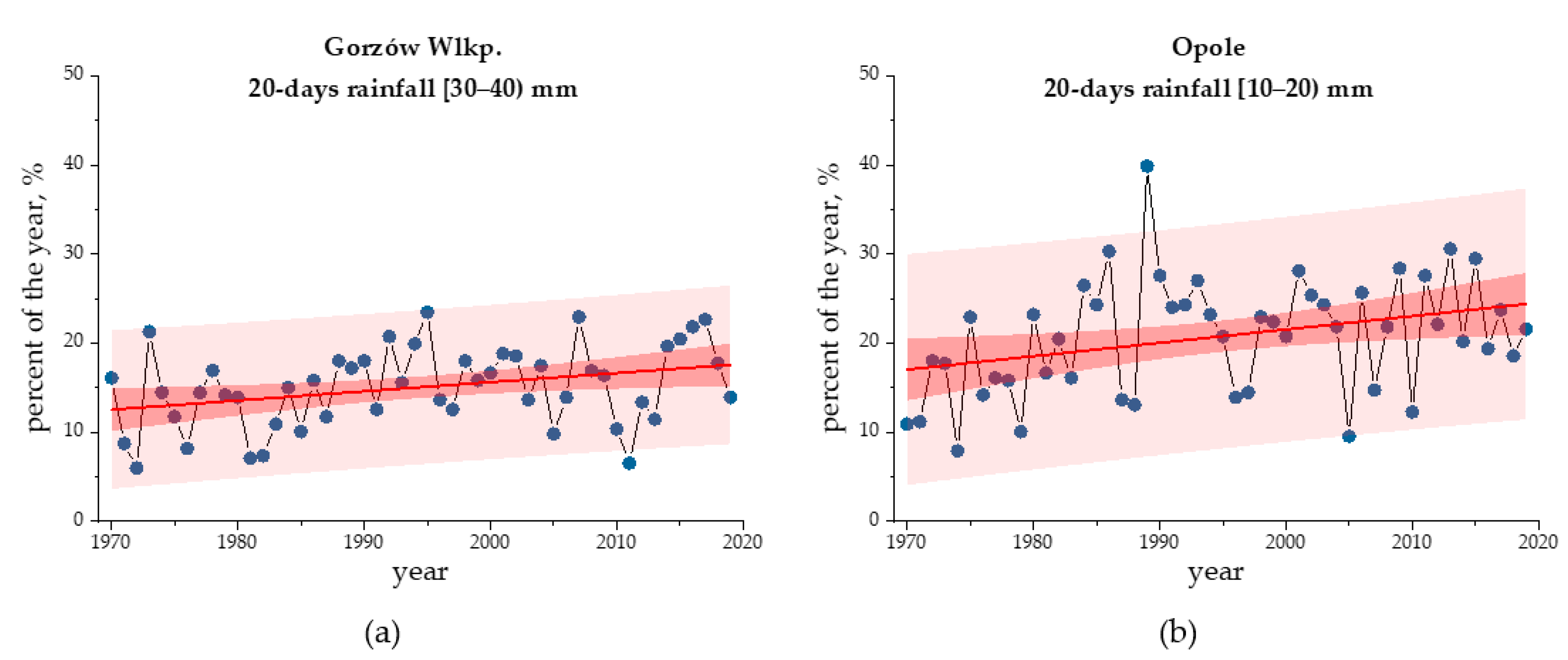
| Household 1 | Household 2 | Household 3 | Household 4 | |
|---|---|---|---|---|
| 20-day rainwater demand | 1000 dm3 | 2000 dm3 | 3000 dm3 | 4000 dm3 |
| Catchment area (roof) | 125 m2 | 125 m2 | 125 m2 | 125 m2 |
| Storage capacity (tank) | 1.0 m3 | 2.0 m3 | 3.0 m3 | 4.0 m3 |
| City | Total Rainfall | Total Rainfall | Total Rainfall | Total Rainfall | ||||||||||||
|---|---|---|---|---|---|---|---|---|---|---|---|---|---|---|---|---|
| ≥10 mm | ≥20 mm | ≥30 mm | ≥40 mm | |||||||||||||
| Min | Mean | Max | SD | Min | Mean | Max | SD | Min | Mean | Max | SD | Min | Mean | Max | SD | |
| Białystok | 74% | 86% | 99% | 7% | 45% | 65% | 90% | 9% | 30% | 45% | 71% | 9% | 13% | 30% | 55% | 9% |
| Gdańsk | 52% | 79% | 98% | 9% | 30% | 54% | 83% | 11% | 16% | 35% | 58% | 10% | 7% | 23% | 43% | 8% |
| Gorzów Wlkp. | 68% | 84% | 95% | 7% | 35% | 61% | 86% | 11% | 13% | 41% | 66% | 12% | 5% | 26% | 45% | 10% |
| Katowice | 73% | 90% | 98% | 6% | 58% | 74% | 87% | 8% | 35% | 56% | 75% | 10% | 16% | 40% | 58% | 10% |
| Kielce | 67% | 86% | 100% | 7% | 47% | 67% | 95% | 9% | 24% | 46% | 68% | 9% | 12% | 30% | 44% | 8% |
| Koszalin | 71% | 89% | 99% | 6% | 43% | 73% | 91% | 9% | 31% | 56% | 77% | 10% | 19% | 41% | 67% | 11% |
| Kraków | 72% | 88% | 98% | 6% | 47% | 69% | 85% | 9% | 30% | 49% | 67% | 9% | 14% | 33% | 52% | 8% |
| Lublin | 66% | 84% | 96% | 7% | 39% | 63% | 84% | 9% | 23% | 42% | 62% | 9% | 5% | 28% | 43% | 9% |
| Łódź | 69% | 85% | 97% | 7% | 47% | 64% | 86% | 9% | 26% | 43% | 72% | 10% | 7% | 27% | 51% | 9% |
| Olsztyn | 73% | 88% | 99% | 6% | 41% | 68% | 91% | 10% | 21% | 49% | 71% | 10% | 11% | 34% | 55% | 10% |
| Opole | 69% | 85% | 97% | 7% | 37% | 65% | 86% | 10% | 19% | 45% | 66% | 11% | 5% | 30% | 50% | 9% |
| Poznań | 64% | 82% | 94% | 9% | 33% | 58% | 80% | 12% | 9% | 35% | 57% | 12% | 1% | 22% | 40% | 10% |
| Rzeszów | 67% | 87% | 99% | 7% | 34% | 66% | 84% | 11% | 15% | 46% | 68% | 11% | 9% | 32% | 50% | 10% |
| Suwałki | 75% | 87% | 98% | 6% | 49% | 66% | 83% | 9% | 29% | 47% | 73% | 8% | 15% | 31% | 54% | 8% |
| Szczecin | 59% | 84% | 98% | 8% | 39% | 63% | 85% | 10% | 14% | 41% | 66% | 11% | 5% | 27% | 47% | 9% |
| Toruń | 63% | 83% | 98% | 8% | 31% | 58% | 77% | 10% | 8% | 37% | 56% | 11% | 0% | 23% | 43% | 9% |
| Warsaw | 65% | 82% | 95% | 8% | 43% | 59% | 81% | 9% | 23% | 37% | 63% | 9% | 5% | 24% | 42% | 8% |
| Wrocław | 67% | 83% | 95% | 7% | 41% | 59% | 77% | 8% | 20% | 39% | 56% | 9% | 12% | 26% | 46% | 8% |
| Zielona Góra | 70% | 85% | 96% | 6% | 40% | 64% | 83% | 9% | 22% | 44% | 63% | 10% | 7% | 27% | 50% | 10% |
| City | Total Rainfall | Total Rainfall | Total Rainfall | Total Rainfall | ||||||||||||
|---|---|---|---|---|---|---|---|---|---|---|---|---|---|---|---|---|
| [0–10) mm | [10–20) mm | [20–30) mm | [30–40) mm | |||||||||||||
| Min | Mean | Max | SD | Min | Mean | Max | SD | Min | Mean | Max | SD | Min | Mean | Max | SD | |
| Białystok | 1% | 14% | 26% | 7% | 5% | 21% | 34% | 6% | 6% | 20% | 31% | 5% | 7% | 15% | 30% | 5% |
| Gdańsk | 2% | 21% | 48% | 9% | 12% | 25% | 42% | 6% | 8% | 19% | 30% | 5% | 2% | 12% | 25% | 5% |
| Gorzów Wlkp. | 5% | 16% | 32% | 7% | 9% | 23% | 39% | 8% | 11% | 20% | 32% | 5% | 6% | 15% | 23% | 4% |
| Katowice | 2% | 10% | 27% | 6% | 5% | 16% | 30% | 5% | 10% | 18% | 28% | 5% | 6% | 16% | 27% | 5% |
| Kielce | 0% | 14% | 33% | 7% | 5% | 19% | 31% | 6% | 11% | 21% | 33% | 5% | 6% | 16% | 30% | 5% |
| Koszalin | 1% | 11% | 29% | 6% | 7% | 16% | 34% | 5% | 9% | 17% | 28% | 5% | 6% | 15% | 23% | 4% |
| Kraków | 2% | 12% | 28% | 6% | 6% | 19% | 35% | 6% | 9% | 20% | 33% | 6% | 6% | 16% | 25% | 5% |
| Lublin | 4% | 16% | 34% | 7% | 11% | 22% | 35% | 6% | 10% | 20% | 34% | 5% | 6% | 15% | 24% | 4% |
| Łódź | 3% | 15% | 31% | 7% | 6% | 21% | 31% | 6% | 9% | 22% | 31% | 5% | 5% | 16% | 28% | 5% |
| Olsztyn | 1% | 12% | 27% | 6% | 6% | 20% | 39% | 7% | 9% | 19% | 28% | 5% | 5% | 15% | 26% | 4% |
| Opole | 3% | 15% | 31% | 7% | 8% | 21% | 40% | 7% | 8% | 20% | 32% | 6% | 7% | 14% | 27% | 5% |
| Poznań | 6% | 18% | 36% | 9% | 13% | 25% | 37% | 6% | 11% | 22% | 34% | 5% | 2% | 14% | 25% | 6% |
| Rzeszów | 1% | 13% | 33% | 7% | 9% | 21% | 44% | 7% | 9% | 20% | 36% | 6% | 6% | 14% | 25% | 5% |
| Suwałki | 2% | 13% | 25% | 6% | 5% | 21% | 39% | 6% | 6% | 19% | 30% | 6% | 8% | 16% | 26% | 4% |
| Szczecin | 2% | 16% | 41% | 8% | 8% | 21% | 34% | 6% | 9% | 21% | 36% | 6% | 7% | 15% | 25% | 4% |
| Toruń | 2% | 17% | 37% | 8% | 10% | 25% | 52% | 8% | 11% | 21% | 34% | 5% | 6% | 14% | 23% | 4% |
| Warsaw | 5% | 18% | 35% | 8% | 11% | 24% | 39% | 7% | 9% | 21% | 35% | 5% | 5% | 14% | 28% | 4% |
| Wrocław | 5% | 17% | 33% | 7% | 10% | 24% | 42% | 8% | 9% | 19% | 30% | 5% | 1% | 14% | 27% | 5% |
| Zielona Góra | 4% | 15% | 30% | 6% | 9% | 21% | 38% | 6% | 11% | 20% | 35% | 5% | 7% | 17% | 27% | 5% |
| City | Cumulative 20-Day Rainfall ≥10 mm | Cumulative 20-Day Rainfall ≥20 mm | Cumulative 20-Day Rainfall ≥30 mm | Cumulative 20-Day Rainfall ≥40 mm | ||||||||
|---|---|---|---|---|---|---|---|---|---|---|---|---|
| (%) | (%) | (%) | (%) | |||||||||
| Białystok | 39 | 0.04 | 25% | 91 | 0.09 | 55% | 178 | 0.13 | 86% | 36 | 0.03 | 23% |
| Gdańsk | −24 | −0.02 | 15% | −72 | −0.07 | 45% | −170 | −0.15 | 84% | −125 | −0.10 | 70% |
| Gorzów Wlkp. | 124 | 0.07 | 70% | 94 | 0.09 | 56% | 98 | 0.12 | 58% | 32 | 0.03 | 20% |
| Katowice | 2 | 0.00 | 1% | −67 | −0.05 | 42% | −151 | −0.09 | 79% | −142 | −0.11 | 76% |
| Kielce | 95 | 0.05 | 57% | −24 | −0.01 | 15% | 14 | 0.01 | 9% | −1 | 0.00 | 0% |
| Koszalin | 203 | 0.10 | 91% | 104 | 0.09 | 61% | 82 | 0.08 | 50% | 43 | 0.04 | 27% |
| Kraków | −10 | 0.00 | 6% | −32 | −0.02 | 20% | −102 | −0.09 | 60% | −82 | −0.07 | 50% |
| Lublin | 175 | 0.11 | 85% | 4 | 0.00 | 2% | 32 | 0.02 | 20% | 98 | 0.07 | 58% |
| Łódź | 15 | 0.01 | 9% | 54 | 0.06 | 34% | −32 | −0.02 | 20% | −79 | −0.07 | 49% |
| Olsztyn | 105 | 0.05 | 62% | −3 | 0.00 | 1% | −58 | −0.06 | 37% | −12 | −0.01 | 7% |
| Opole | −156 | −0.09 | 81% | −272 | −0.26 | 98% | −296 | −0.26 | 99% | −385 | −0.27 | 99.9% |
| Poznań | 120 | 0.07 | 68% | 150 | 0.16 | 79% | 161 | 0.17 | 82% | 188 | 0.14 | 88% |
| Rzeszów | 113 | 0.07 | 65% | 51 | 0.05 | 32% | −14 | −0.02 | 9% | −53 | −0.04 | 34% |
| Suwałki | 118 | 0.07 | 67% | 169 | 0.14 | 84% | 126 | 0.11 | 70% | 122 | 0.09 | 69% |
| Szczecin | 179 | 0.14 | 86% | 153 | 0.13 | 80% | 136 | 0.15 | 74% | 121 | 0.12 | 68% |
| Toruń | 147 | 0.11 | 78% | 10 | 0.01 | 6% | 23 | 0.03 | 15% | 24 | 0.02 | 15% |
| Warsaw | 136 | 0.10 | 74% | 56 | 0.06 | 35% | 86 | 0.07 | 52% | −6 | 0.00 | 3% |
| Wrocław | −37 | −0.02 | 24% | −169 | −0.11 | 84% | −194 | −0.17 | 89% | −352 | −0.23 | 99.7% |
| Zielona Góra | 41 | 0.03 | 26% | 109 | 0.09 | 63% | 228 | 0.17 | 94% | 120 | 0.11 | 68% |
| City | Cumulative 20-Day Rainfall [0–10) mm | Cumulative 20-Day Rainfall [10–20) mm | Cumulative 20-Day Rainfall [20–30) mm | Cumulative 20-Day Rainfall [30–40) mm | ||||||||
|---|---|---|---|---|---|---|---|---|---|---|---|---|
| (%) | (%) | (%) | (%) | |||||||||
| Białystok | −39 | −0.04 | 25% | −104 | −0.06 | 61% | −129 | −0.06 | 72% | 132 | 0.05 | 73% |
| Gdańsk | 24 | 0.02 | 15% | 100 | 0.07 | 59% | 174 | 0.08 | 85% | −162 | −0.07 | 82% |
| Gorzów Wlkp. | −124 | −0.07 | 70% | −125 | −0.08 | 70% | −16 | 0.00 | 10% | 271 | 0.11 | 98% |
| Katowice | −2 | 0.00 | 1% | 169 | 0.07 | 84% | 163 | 0.07 | 82% | 49 | 0.03 | 31% |
| Kielce | −95 | −0.05 | 57% | 126 | 0.07 | 70% | −51 | −0.03 | 32% | −21 | 0.00 | 13% |
| Koszalin | −203 | −0.10 | 91% | −23 | −0.01 | 15% | 89 | 0.03 | 54% | 209 | 0.08 | 92% |
| Kraków | 10 | 0.00 | 6% | 30 | 0.02 | 19% | 76 | 0.04 | 47% | −71 | −0.03 | 44% |
| Lublin | −175 | −0.11 | 85% | 184 | 0.09 | 87% | −57 | −0.02 | 36% | −111 | −0.05 | 64% |
| Łódź | −15 | −0.01 | 9% | −74 | −0.03 | 46% | 156 | 0.07 | 81% | 42 | 0.02 | 27% |
| Olsztyn | −105 | −0.05 | 62% | 44 | 0.02 | 28% | 94 | 0.05 | 56% | −43 | −0.02 | 27% |
| Opole | 156 | 0.09 | 81% | 268 | 0.15 | 97% | 97 | 0.06 | 58% | −25 | −0.01 | 16% |
| Poznań | −120 | −0.07 | 68% | −202 | −0.12 | 91% | −55 | −0.03 | 35% | 51 | 0.03 | 32% |
| Rzeszów | −113 | −0.07 | 65% | 69 | 0.03 | 43% | 57 | 0.02 | 36% | 187 | 0.09 | 88% |
| Suwałki | −118 | −0.07 | 67% | −114 | −0.05 | 66% | 43 | 0.02 | 27% | 34 | 0.01 | 22% |
| Szczecin | −179 | −0.14 | 86% | −61 | −0.03 | 38% | 52 | 0.02 | 33% | 109 | 0.04 | 63% |
| Toruń | −147 | −0.11 | 78% | 130 | 0.07 | 72% | 38 | 0.02 | 24% | −62 | −0.02 | 39% |
| Warsaw | −136 | −0.10 | 74% | 36 | 0.02 | 23% | 4 | 0.00 | 2% | 204 | 0.06 | 91% |
| Wrocław | 37 | 0.02 | 24% | 162 | 0.10 | 82% | 86 | 0.03 | 52% | 159 | 0.08 | 81% |
| Zielona Góra | −41 | −0.03 | 26% | −229 | −0.11 | 94% | −116 | −0.04 | 66% | 210 | 0.09 | 92% |
© 2020 by the authors. Licensee MDPI, Basel, Switzerland. This article is an open access article distributed under the terms and conditions of the Creative Commons Attribution (CC BY) license (http://creativecommons.org/licenses/by/4.0/).
Share and Cite
Canales, F.A.; Gwoździej-Mazur, J.; Jadwiszczak, P.; Struk-Sokołowska, J.; Wartalska, K.; Wdowikowski, M.; Kaźmierczak, B. Long-Term Trends in 20-Day Cumulative Precipitation for Residential Rainwater Harvesting in Poland. Water 2020, 12, 1932. https://doi.org/10.3390/w12071932
Canales FA, Gwoździej-Mazur J, Jadwiszczak P, Struk-Sokołowska J, Wartalska K, Wdowikowski M, Kaźmierczak B. Long-Term Trends in 20-Day Cumulative Precipitation for Residential Rainwater Harvesting in Poland. Water. 2020; 12(7):1932. https://doi.org/10.3390/w12071932
Chicago/Turabian StyleCanales, Fausto A., Joanna Gwoździej-Mazur, Piotr Jadwiszczak, Joanna Struk-Sokołowska, Katarzyna Wartalska, Marcin Wdowikowski, and Bartosz Kaźmierczak. 2020. "Long-Term Trends in 20-Day Cumulative Precipitation for Residential Rainwater Harvesting in Poland" Water 12, no. 7: 1932. https://doi.org/10.3390/w12071932
APA StyleCanales, F. A., Gwoździej-Mazur, J., Jadwiszczak, P., Struk-Sokołowska, J., Wartalska, K., Wdowikowski, M., & Kaźmierczak, B. (2020). Long-Term Trends in 20-Day Cumulative Precipitation for Residential Rainwater Harvesting in Poland. Water, 12(7), 1932. https://doi.org/10.3390/w12071932








